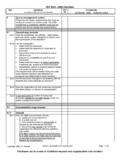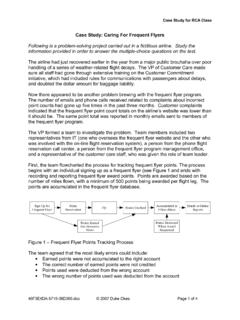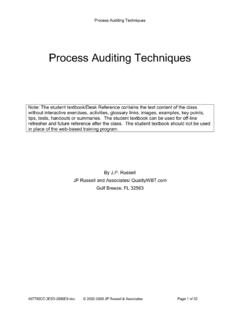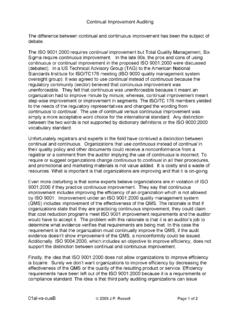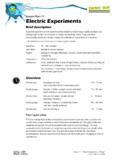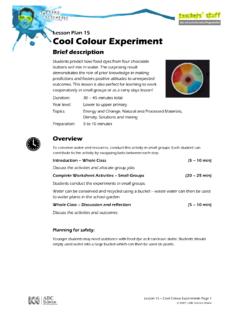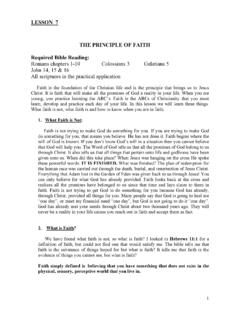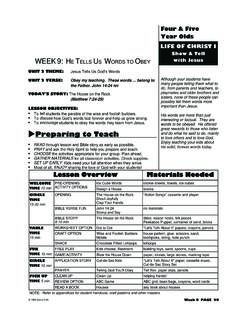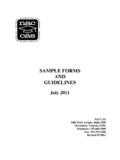Transcription of Internal Auditing Basics - QualityWBT Center for …
1 Student Desk Reference Internal Auditing Basics : plan , Perform, Report, and Follow-up By: Russell Note: The student textbook contains the text content of the class without interactive exercises, activities, glossary links, images, examples, key points, tips, tests, handouts or summaries. The student textbook can be used for off-line refresher and future reference after the class. The student textbook should not be used in place of the web-based training program. Internal Auditing Basics 2002-2009 JP Russell & Associates Page 2 of 48 20 Basic Audit Principles By: Russell Auditor Conduct 1.
2 Do not disclose auditee proprietary information to others. 2. Be honest and impartial by avoiding conflicts of interest. 3. When unethical activities are observed, verify it, record it, and report it. 4. Protect auditee property entrusted to you. 5. Support the advancement of the public well being for safe products and services. Preparing 6. Ensure sufficient resources are available to accomplish the purpose of the audit. 7. Verify there is an established system/ process to audit before the audit. 8. Assigned auditors must be competent/ qualified. 9. Communicate agreed upon information to auditee such as audit times, purpose, areas to be audited, and standards to be audited against.
3 Performing 10. Verify conformance to agreed upon requirements (the rules). Auditors don t determine auditee requirements. 11. Ensure sufficient samples (records, product, processes, interviews, etc.) are taken to match the purpose and scope of the audit. 12. Stay within the agreed scope unless the degree of risk necessitates other actions. 13. Samples must be random and representative unless specified objectives require otherwise. 14. Conformance and nonconformance must be verifiable and traceable. 15. Comply with auditee rules (safety, health, restricted areas, etc.)
4 16. Keep auditee informed of the audit progress Reporting 17. Report the results of the investigation truthfully and in a clear, correct, concise, and complete manner. 18. Communicate the importance of findings/ nonconformities. 19. Ensure results are traceable to requirements. 20. Do not take ownership of problems found Internal Auditing Basics 2002-2009 JP Russell & Associates Page 3 of 48 Internal Auditing Basics Desk Reference Table of Contents Lesson 1: Welcome to Auditing .. 4 Lesson 2: Getting the Assignment .. 7 Lesson 3: Audit Service Inputs (purpose and scope).
5 9 Lesson 4: Preparing for the 12 Lesson 5: Identifying Requirements and 14 Lesson 6: Desk Audit and Audit 19 Lesson 7: Beginning the Audit .. 23 Lesson 8: Data 27 Lesson 9: Applying Process Techniques/ Process Auditing .. 32 Lesson 10: Analyzing the 36 Lesson 11: Reporting and Follow-up Actions .. 40 Lesson 12: Audit Follow-up, Corrective Action and Closure .. 44 Internal Auditing Basics 2002-2009 JP Russell & Associates Page 4 of 48 Lesson 1: Welcome to Auditing Whether you are learning Auditing conventions to qualify as an Internal auditor or for self-improvement, both you and your organization will benefit.
6 Your organization will benefit because you will be a more effective auditor and you will benefit because you will learn new skills. Not only will you be learning new skills in Auditing but you can also use these skills in other job responsibilities, be able to link requirements to your job, and improve your everyday communication skills by practicing interviewing techniques. An audit is some type of formal independent examination of product, service, work process, department, or organization. Conducting an audit is a process, work practice or service. Some organizations prefer the word evaluation, survey, review, or assessment instead of the word audit.
7 I will use the word audit because it is universally accepted and, to experts, it means a certain type of investigation or examination. Since auditors are entrusted with information, they must be ethical in their dealings with the organizations they audit as well as with the general public. From time to time I will highlight one of the 20 Audit Principles to emphasize its importance. All 20 Audit Principles are listed in the front of the book. Audit Principle: Use knowledge and skills for the advancement of public welfare. The audit process (Figure 1-1) steps are to: Identify plans (what people are supposed to do) Make observations (what people are actually doing) Evaluate the facts collected (sort the evidence) Report the results (conformance or noncompliance) A.
8 Terminology This Chapter is about the ABC s of Auditing to help you communicate effectively. Your organization may have its own name for things that are different from standard audit terms or even different from the dictionary. If the terminology in the text starts to get confusing, consider starting your own cross reference showing the word you are familiar with compared to the more generic terminology. You can start with the following example table. Example Table Your Terminology Cross-reference Table No. Universal Terminology Your Organization s Term 1.
9 Audit Assessment, evaluation 2. Survey Review 3. Audit Program Department Regulatory Compliance Dept. 4. Employee Associate 5. Customer Client 6. Client Program Manager, Quality Mgr. 7. Audit Program Manager Compliance Director B. Controls to Examine An audit is a process of investigating and examining evidence to determine whether agreed-upon requirements are being met. An effective audit depends on how information is gathered, analyzed and reported. The results may verify conformance or specify noncompliance to rules, standards, or regulations.
10 A quality audit is linked to quality requirements, environment to environmental requirements, financial audits to financial statements, and safety audits to safety rules and regulations. One of the things that make an audit different from an inspection is that the individual performing an audit must be Internal Auditing Basics 2002-2009 JP Russell & Associates Page 5 of 48 able to do so impartially and objectively. It means the person performing the audit must be independent of or have no vested interest in the area being audited. The level of independence necessary to ensure impartiality and objectivity will vary from industry to industry, type of organization and organization culture.
